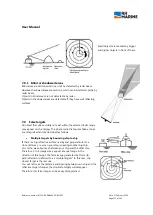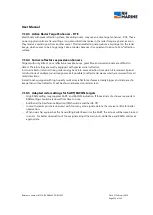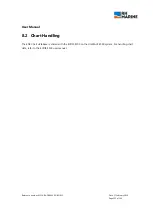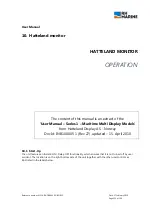
User Manual
Reference number: 4111A-RADAR4600-GBD-R1.1
Date: 27 February 2018
Page 128 of 149
7.12
Target detection in sea clutter
Radar performance predictions provide guidance for target detection however these predictions should only
be seen as a guide. The sea conditions modeled for both following tables, may not reflect the sea conditions
being experienced on a ship at any particular time. Target detection is influenced by relative wind direction
and head wind generates greater radar visible clutter. Calculations assume a 15m antenna height and a
3.5m target height. The probability-of-detection has been simplified and shown as an
O
having a size
proportional to target visibility, based on a probability of false alarm of 10
-4
and calculated at 0.2 and 0.7
NM.
These predictions are without signal processing; the performance will usually improve with processing
applied.
Targets within clutter must compete with the signals generated by the sea and rain, which generate random
radar signals that are often equivalent or greater than a genuine radar target. Typically these targets include
buoys, small boats and yachts therefore there is a real risk of smaller targets not being visible in adverse
clutter conditions. Radar signal processing provides the means to improve the extraction of genuine targets
from clutter.
Sea state should be assessed as a combination of wind speed and wave height. Sea spikes will further
degrade detection and these are typically present in confined waters. Following tables provide guidance
(based on Expert theoretical predictions) for target visibility at specific target ranges close to own ship. The
averaged visibility predictions are for a small target 1m
2
at X-band and 0.1m
2
at S-band. Larger targets of
the same height and at the same range will usually be visible for the same conditions.
Target
RCS
(m
2
)
X
-band frequency: Target visibility
Sea state 1
wind 5-7Kn,
wave ht:
0.6m
Sea state 2
wind 7-10Kn,
wave ht: 0.9m
Sea state 3
wind 12-
16Kn, wave
ht: 1.2m
Sea state 4
wind 17-
19Kn, wave
ht: 2m
Sea state 5
wind 20-
25Kn, wave
ht: 3m
Sea state 6
wind 26-
33Kn, wave
ht: 4m
0.1
O
O
O
O
O
O
O
o
-
-
-
-
0.5
O
O
O
O
O
O
O
O
O
O
O
O
1.0
O
O
O
O
O
O
O
O
O
O
O
O
Detection predictions in sea clutter conditions: X-band
Target
RCS
(m
2
)
S
-band frequency : Target visibility
Sea state 1
wind 5-7Kn,
wave ht:
0.6m
Sea state 2
wind 7-10Kn,
wave ht:
0.9m
Sea state 3
wind 12-
16Kn, wave
ht: 1.2m
Sea state 4
wind 17-
19Kn, wave
ht: 2m
Sea state 5
wind 20-
25Kn, wave
ht: 3m
Sea state 6
wind 26-
33Kn, wave
ht: 4m
0.1
O
O
O
O
O
O
O
O
O
-
o
-
0.5
O
O
O
O
O
O
O
O
O
O
O
O
1.0
O
O
O
O
O
O
O
O
O
O
O
O
Detection predictions in sea clutter conditions: S-band
(Key for visibility of targets in above shown tables:
O
>80%, O >50%, o >10%,
- <10%
).
Note:
Inside of sea clutter area, selection of S-band radar will improve the ability to detect small
targets. But in wide sea areas, where steady big wave lines run in same direction, it will be
better to select X-band radar and shorter impulse length to get separation of wave lines
in radar image. Then smaller targets are detectable between the wave lines.















































